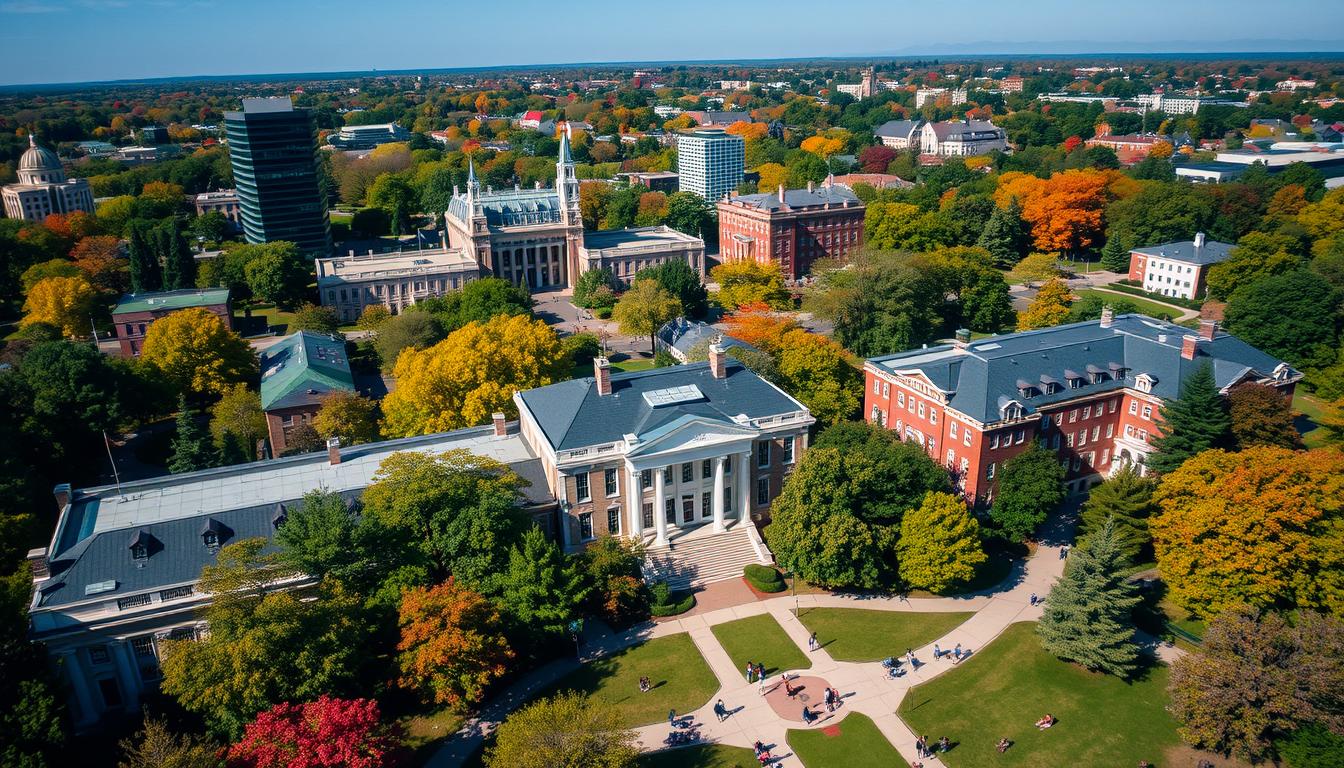The United States is famous for its top-notch higher education. It draws many international students every year. Knowing the costs is key for these students to plan their studies well.
Tuition fees and living costs are big parts of the cost of studying in the USA. The total cost covers tuition, fees, housing, health insurance, and other expenses. For more details, check out Kadamboverseas. They offer in-depth information on studying costs in the USA.

Key Takeaways
- Tuition fees vary a lot between public and private schools.
- Accommodation costs can be from $500 to $2,000 monthly.
- Health insurance is a must for international students.
- Other living expenses, like food and transport, also increase the total cost.
- Knowing these costs is vital for good financial planning.
The American Education Value Proposition in 2026
As we near 2026, American education’s appeal is as strong as ever. It attracts students from all over the world. The USA’s universities are among the best globally, with top business schools. A US degree is highly sought after in the job market.
Why International Student Enrollment Continues to Rise
More international students are choosing the US for its academic excellence and research opportunities. US schools offer state-of-the-art facilities and cutting-edge research programs. These draw students from around the world.
Students also value the cultural diversity and campus life at American universities. Being part of a multicultural community enriches their learning. It prepares them for a global job market.
Economic and Career Benefits of US Degrees
Having a US degree opens many career doors worldwide. The economic benefits are significant, with graduates often earning high salaries. Here are some recent statistics:
| Degree Level | Average Starting Salary | Employment Rate |
|---|---|---|
| Bachelor’s | $60,000 | 80% |
| Master’s | $80,000 | 90% |
| Ph.D. | $100,000 | 95% |
For more on master’s programs in the USA, visit Kadamboverseas.
Projected Changes in International Education Landscape
Looking to 2026, the international education scene will see changes. There will be more focus on online and hybrid learning models. Sustainability and global issues will also take center stage. Expect more collaborations between universities and industry partners.
US universities will likely adapt their programs to meet international students’ needs. This will keep the American education value proposition strong.
Complete Breakdown of the Cost of Study in USA for International Students
More and more international students are heading to the USA. It’s key to know the costs involved. These include tuition, living expenses, and health insurance.
Average Total Annual Budget for International Students
The costs for international students vary a lot. For example, at Stony Brook University, an F-1 undergraduate student pays between $62,224 and $63,574 a year.
Cost Differences Between Urban and Rural Campuses
Living costs differ a lot between cities and countryside. Places like New York City are pricier than rural areas.
Projected Inflation Rates for Education Costs in 2026
Education costs are set to go up because of inflation. Knowing this helps students budget better.
| Expense Category | Urban Campus | Rural Campus |
|---|---|---|
| Tuition Fees | $30,000 – $50,000 | $20,000 – $40,000 |
| Living Expenses | $15,000 – $25,000 | $8,000 – $18,000 |
| Health Insurance | $1,500 – $2,500 | $1,500 – $2,500 |
| Total | $46,500 – $77,500 | $29,500 – $60,500 |
Tuition Fees by Institution Type and Program
The type of school and program you choose affects your tuition fees. It’s important to plan your budget based on your goals and what you can afford.
Community Colleges
Community colleges are a budget-friendly option for international students. Tuition fees are between $5,000 and $15,000 a year. They are a good starting point for general education before moving to a four-year university.
State Universities
State universities cost more than community colleges but are cheaper than private schools. Tuition for international students is between $20,000 and $40,000 a year. They offer a wide range of undergraduate and graduate programs.
Private Universities
Private universities are the priciest option, with fees from $35,000 to $60,000 a year. They provide specialized programs, smaller classes, and more resources.
Graduate and Professional Program Premium Costs
Graduate and professional programs have higher costs. For example, MBA programs can be over $100,000. Medical and law programs also have unique fee structures.
| Institution Type | Tuition Fee Range (Annual) |
|---|---|
| Community Colleges | $5,000 – $15,000 |
| State Universities | $20,000 – $40,000 |
| Private Universities | $35,000 – $60,000 |
Housing and Accommodation Expenses Across Regions
Housing costs are a big part of studying in the United States. For international students, knowing these costs is key for planning their finances.
Dormitory and On-Campus Housing: $10,000-$15,000 Annually
Living on campus offers convenience and community. Costs range from $10,000 to $15,000 a year. A study found that students living on campus do better academically and socially.
“The residence hall experience is a critical component of the college experience,” says a university administrator.
Off-Campus Apartments: Regional Price Variations
Off-campus living gives students more freedom but costs vary by region. Cities like New York or San Francisco are pricier than smaller towns. Looking for apartments outside the city center or sharing with roommates can help save money. For more on tuition, check out tuition fees in USA for international students.
Cost-Saving Housing Alternatives for Budget-Conscious Students
For those watching their budget, homestays or shared housing can cut costs. Universities may also help find affordable places to live. “Choosing smart housing can greatly help with living expenses,” advises a financial advisor for students.
Food, Transportation, and Essential Living Expenses
International students heading to the United States need to manage their living costs. These costs include food, transportation, and daily needs. They are key for a good and successful college experience.
Campus Meal Plans: $3,000-$6,000 Per Academic Year
Food is a big expense for international students. Campus meal plans cost between $3,000 and $6,000 a year. They offer flexibility and can meet different dietary needs.
Some universities have meal plans with dining dollars. These dollars can be used at many campus eateries.
Grocery and Dining Out Costs in College Towns
Students who don’t want a meal plan can shop for groceries. Grocery prices vary by location. College towns have many stores, from cheap to specialty.
Dining out also adds to food costs. Prices change based on the food and where you eat.
Transportation Options: From Campus Shuttles to Car Ownership
Transportation is another big cost. Universities often have shuttles and public transport. This makes it easy to get around without a car.
But, some students might want a car. This means extra costs for insurance, parking, and upkeep. For more on managing money and aid, check out scholarships for international students.
Monthly Budget Breakdown for Daily Necessities
A monthly budget for daily needs can vary. Here’s a rough guide: $300-$500 for groceries, $100-$300 for eating out, and $50-$100 for transport. Knowing these costs helps students plan their money better.
Mandatory Health Insurance and Healthcare Costs
International students need to know about health insurance to handle healthcare costs. Health insurance is a must for students in the United States. It costs between $1,500 to $2,500 a year, depending on the university’s plan.
University Health Insurance Plans
Most universities in the USA have their own health insurance for international students. These plans cover doctor visits, hospital stays, and emergency care. The cost for these plans varies a lot, based on the university and coverage level.

Coverage Requirements and Waiver Options
International students must have health insurance that meets their university’s minimum requirements. Some students might get a waiver if they have similar coverage from another source, like a parent’s plan. It’s important to know these rules and the waiver process to manage healthcare costs.
Accessing Healthcare Services
With insurance, international students can get many healthcare services. Universities often have on-campus health clinics for primary care. This makes it easy for students to get medical help when they need it.
Academic Materials and Technology Requirements
For international students planning to study in the USA, knowing the costs of academic materials and technology is key. These costs can change a lot based on the field of study and the program’s needs.
Textbooks and Course Materials: $500-$1,200 Per Year
Textbooks and course materials can cost between $500 and $1,200 each year. To save money, students can choose used or digital textbooks. They can also rent textbooks for certain courses.
Field-Specific Equipment and Software Costs
Some fields need extra equipment or software, which can increase costs. For example, engineering students might need expensive software or hardware. But, many universities offer discounted rates for students.
Digital Alternatives and Resource Sharing Strategies
To cut costs, students can look into digital alternatives like e-books and online resources. Sharing resources with classmates is another smart move. Many schools also provide free or low-cost access to software and tools.
By using these strategies, international students can manage their expenses on academic materials and technology. This makes their education more affordable.
International Student Administrative Fees
Administrative fees are a big deal for international students going to US universities. These costs, though not as high as tuition, can add up. They play a role in a student’s financial planning.
F-1 Visa Application: $160 Plus SEVIS Fee of $350
Getting an F-1 visa comes with several expenses. The visa application fee is $160, and there’s a $350 SEVIS fee. So, the total is $510.
University Application Fees: $50-$150 Per School
International students often apply to many universities. This means they pay fees ranging from $50 to $150 for each school. It can get expensive, mainly if they apply to several places.

Standardized Testing Costs: TOEFL, GRE, GMAT, SAT
Standardized tests are key in the application process. The costs differ: TOEFL ($200-$250), GRE ($205), GMAT ($250), and SAT ($55-$70). There are also extra fees for late registration or changes.
Banking, Currency Exchange, and Wire Transfer Fees
International transactions come with extra fees. Students need to know about banking fees, currency exchange rates, and wire transfer charges. These are important when sending money to the US.
| Fee Type | Cost Range |
|---|---|
| F-1 Visa Application | $160 + $350 SEVIS fee |
| University Application | $50-$150 per school |
| Standardized Tests | $55-$250 per test |
| Banking and Wire Transfer | Variable |
It’s important for international students to know about these fees. This helps them plan their budget for studying in the US.
Scholarships and Financial Support Systems
The USA has many scholarships and financial support systems for international students. These help make studying here more affordable.
Full-Ride Scholarships at Top US Universities
Top universities in the USA give full-ride scholarships to top international students. Harvard University, for example, offers full-ride scholarships. These cover tuition, room, and board for students from low-income backgrounds.
“Financial aid is available to all students, regardless of nationality, and we encourage you to apply.”
Harvard University Admissions
Discipline-Specific Funding Opportunities
There are scholarships for specific fields. The National Science Foundation gives scholarships for STEM fields.
Country-Based Scholarship Programs
Some scholarships are for students from certain countries. The Fulbright Program offers scholarships to students from many countries to study in the USA.
Fellowship and Assistantship Positions for Graduate Students
Graduate students can find fellowships and assistantships. Many universities offer teaching or research assistantships. These provide a stipend and tuition waiver.
| Scholarship Type | Eligibility | Awards |
|---|---|---|
| Full-Ride Scholarships | Outstanding international students | Tuition, room, and board |
| Discipline-Specific | Students in specific fields (e.g., STEM) | Varies by program |
| Country-Based | Students from specific countries | Varies by program |
Strategic Approaches to Financing Your US Education
International students can use many financial strategies to fund their US education. It’s important to plan well to handle the high costs of studying in the US.
Legal Work Options: On-Campus Jobs and OPT Opportunities
Legal work options are a key way to finance your education. You can find on-campus jobs that are easy to get and let you earn money while studying. Also, the Optional Practical Training (OPT) program lets you work in your field for up to 12 months after graduation. This gives you valuable work experience and helps financially.
- On-campus jobs: Available during the academic year
- OPT Opportunities: Available post-graduation for up to 12 months
- CPT (Curricular Practical Training): Available during the course of study
Effective Budgeting Tools for International Students
Using good budgeting tools is key to managing your money. International students can use budgeting apps and spreadsheets to keep track of their money. Making a budget helps you see where you can cut costs and use your money wisely.
- Track monthly expenses
- Set financial goals
- Prioritize needs over wants
Leveraging Exchange Rates and International Banking
Knowing how to use exchange rates can really help your finances. International students should know the current exchange rates and use international banking services that offer good deals. This can help you save on fees and get more value from your money.
Timeline for Financial Planning: From Application to Graduation
Having a financial plan from application to graduation is essential. This means researching and applying for scholarships, understanding tuition fees, and planning for living costs. A good financial plan helps avoid financial stress and makes your academic journey smoother.
For more detailed information on the requirements for studying in the US, visit Study in USA for International Students.
Conclusion: Maximizing Your Educational Investment in America
International students thinking about studying in the USA need to know about costs and financial aid. This knowledge helps them make smart choices about their education.
Students can plan and budget for things like tuition, housing, food, and transportation. This way, they get the most out of their US education.
Looking into scholarships and financial support can also help. It’s a way to fund their studies and reach their academic goals.
Studying in the USA can be a great investment in your future. It offers economic and career benefits that last long after you graduate.
With good planning and financial management, international students can get the most out of their education in America.
The budget for international students in the USA varies. It depends on the school and where it’s located. It can be from $20,000 to $60,000 or more each year.
Tuition fees change a lot between school types. Community colleges cost $5,000-$15,000 yearly. State universities are $20,000-$40,000 yearly. Private universities can be $35,000-$60,000 yearly.
Housing costs for international students vary. Dorms and on-campus housing cost $10,000 to $15,000 yearly. Off-campus apartments can cost more, depending on where you are.
International students must have health insurance. University plans cost $1,500-$2,500 yearly. Each school has its own rules for coverage.
International students can get many scholarships. There are full-ride scholarships and funding for specific subjects. There are also scholarships for students from certain countries and graduate positions.
Students pay $500-$1,200 yearly for textbooks and materials. They also need to buy field-specific equipment and software.
International students face several fees. There’s the F-1 visa application ($160 + SEVIS fee $350) and university application fees ($50-$150). They also need to pay for standardized tests and banking fees.
Students can find legal work to help pay for school. They can also budget well and use exchange rates. Planning ahead is key to financing their education.
Students can save money by using campus meal plans and shopping for groceries. They can also use campus shuttles or own a car.






